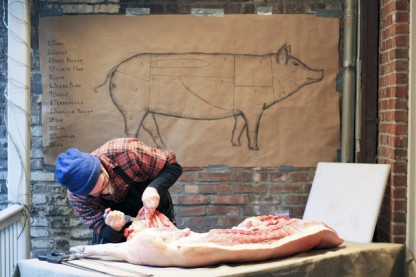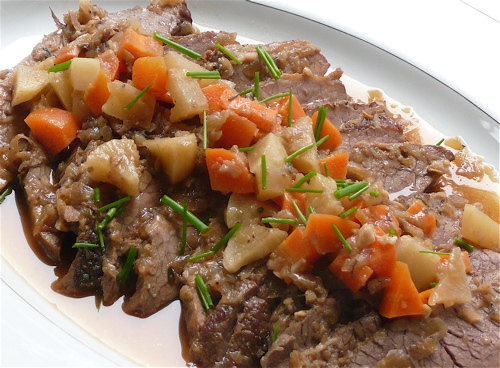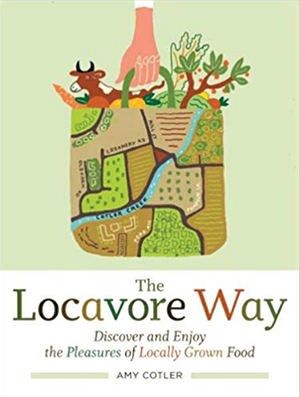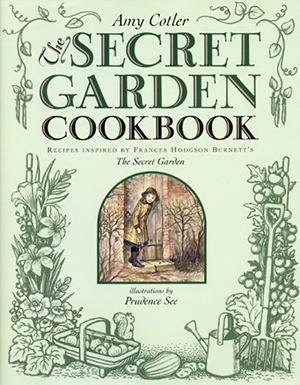In this issue
(in order)
Brisket Recipe for Passover (or whenever!)
Alternatives to Brisket from Roving Butcher Jake Levin.
Sustainable Meat Primer — the works
My Grandma Rose didn’t like to cook much, but she made a mean holiday brisket that’s better than it sounds — foil wrapped and braised tender with a package of Lipton’s soup and a diced green pepper. Times have changed and so has my palette, but the principle remains: slow cooked brisket with lots of onions, in this case real.
This version also includes guilt-free organic beef from McEnroe Organic farm in Millerton, New York and beer from the Barrington Brewery in Great Barrington, Massachusetts. (And if you have it, use home dried thyme from the fall and the first of the garden chives.) This year, as I moved to Northampton, MA, I’m buying my brisket from the new “clean meat” butcher, Sutters’s Meat Market. Serves 8
Tips: Cook at least the day before it’s eaten, but it’s tasty prepared up to 3 days beforehand. Serve with mashed or boiled potatoes, plain or lightly buttered.
1 5 or so pound brisket, first cut if possible
1 tablespoon kosher salt
1 tablespoon fresh thyme leaves (or 2 teaspoons dried)
A generous amount of freshly ground pepper
2 tablespoons flour
1/4 cup vegetable oil
1 cup beer, dark is great, but any good beer will do
1 cup beef or chicken broth
10 garlic cloves, chopped
2 pounds onions, preferably large sweet onions, chopped
1 tablespoon dark unsulphured molasses
2 tablespoons cider vinegar, or to taste
Optional garnish:
2 cups diced root vegetables, such as carrots and turnips
1 tablespoons first of the season chives, chopped
1-Preheat oven to 325 degrees. Trim brisket but leave some fat on.
2-Rub the meat with the salt, thyme, pepper and flour. In wide pot or large skillet with sides, sear the meat in hot oil over medium-high heat until well browned, about 5 minutes each side. (If you don’t have a large enough pot, just cut the meat in half.) Remove the meat to a plate.
3- Add the broth to deglaze the pot, scraping up any browned goodies from the bottom. Reduce the heat to low. Stir in the beer and 1 teaspoon molasses. Add the meat back to the pot with the garlic and onions, plastering them on top of the meat. Turn the heat up to boil the liquid, then turn it off.
4-Immediately cover the meat and liquid thoroughly with parchment paper, pressing down to completely cover both. Place the lid on top. Cook in the oven, turning about once an hour, and making sure the meat and liquid are very well covered with the parchment. Remove from the oven when the meat is fork tender, about 3 hours but up to 4. Remove the meat from the pot and refrigerate separately from the gravy overnight or for up to 3 days.
5- About 1 hour before eating: Skim the fat off the top of the gravy and reheat in the pot until hot but not boiling. Season with the cider and remaining 2 teaspoons of molasses. (Taste. If needed, adjust the seasonings with more cider, molasses and salt.) If you are using the vegetables, remove about 1 ladle’s worth of gravy to a small pot. Bring to a boil and add the carrots and turnips. Reduce to a simmer and cover until the vegetables are well cooked, about 20 minutes. Meanwhile, slice the meat thinly across the grain.
6-Shingle the meat on an oven proof platter with a sides. Cover with the gravy, pouring the onions over the meat. Cover very well and heat in the oven for 30 minutes or up to an hour. (If you don’t have an oven proof platter with sides, heat the meat in the gravy together over low heat, then arrange on the platter with the gravy before serving.) If you are using them, right before serving, spoon the warmed vegetables and their juices over the meat. If you like, garnish with garden fresh chives.
The Veggies
It isn’t essential, but I’ve topped this tasty dish with local root vegetables. Use what you can find; celery root and parsnips would work well too. Here, I steamed the last of my produce from Farm at Miller’s Crossing, carrots and turnips from their end of season sale last November. They were stored on the farm all winter long, a great service, but I should have picked them up earlier, because they had sprouted. Still, I count Katie and Chris’s wintered produce as a blessing. Early spring has always been hard in the north country, a season with no crops to harvest and larders running low. But these vegetables are organic, local and tasty enough, especially the turnips. And stored in their flavor is the memory of fall, and of rosy cheeked Katie hanging outside the storage barn with a couple of dogs bounding around her.
Alternatives to Passover Brisket from The Roving Butcher, Jake Levin.
“Brisket is still an option when considering local grass-fed meat. Others great braising cuts are short ribs, chuck roast, and beef shank.
In my family we always roast a leg of lamb as it seems more symbolically appropriate for the pascal holiday; plus we are always sick of braised meat by this time of year.” (Lucky Jake, says I.)
“I tend to buy meat directly from farmers. For lamb I like to go to Kinderhook farm, and for my beef I usually go to North Plain Farm. But, of course, meat bought directly from farms are almost always frozen. If you are looking for some well cut local and pasture raised meat I would go to the Meat Market in Great Barrington, MA or Sutter Meats in Northhampton.”
 Jake Levin of the Roving Butcher
Jake Levin of the Roving Butcher
Sustainable Meat Primer
Conventionally raised beef consumes enormous resources to produce, as well as staining the earth with endless toxins. That’s why many locavores who are carnivores, including myself, try to lower our meat intake. When we do eat meat, we try to eat animals that are raised humanely and sustainably. (Replenishing rather than depleting our resources.) Happily, this relatively guilt-free brisket was make with certified organic grass fed and grain finished beef from McEnroe’s Organic Farm in Millerton New York. (Link above)
What’s the Story with Grass Fed Meat?
When people ask what grass fed-and-finished meat tastes like, Keith Swanson of Thundering Hooves meat buying club tells them it’s stronger and richer tasting, that most people like it, but that it isn’t for everyone. “It’s real beef flavor,” he says. It takes skill to raise tender grass-fed meat. Farmers raising animals on pasture have to be patient because more time is needed to fatten them on grass than grain, and fattened animals produce tender meat. The end results depend on factors consumers can’t control, like the breed and age of the cow, method of slaughtering, and importantly, the quality of the grass (which is why many ranchers who raise cattle this way call themselves “grass farmers”).
The bottom line is that the farmers have to know what they are doing and set high standards for their grass-fed meat, or the meat will be tough. While grass-fed-and-finished beef can be world class and eye opening when it comes to taste, it doesn’t have the same kind of marbleized fat many of us are used to and so requires more attention during cooking. Less plentiful tender cuts, like filet, should be seared and served rare or medium-rare. Less tender cuts are better braised or roasted slowly. Burger can be cooked as usual, and grass-fed burger is extremely flavorful, delicious, and distinctive. Note that many farms finish pasture-raised animals on a little to a lot of grain for a more familiar flavor and to increase marbleized fat for tenderness. So if you can’t find grass-fed-and-finished meat, look for pasture-raised meat that’s finished minimally on local grain and,when possible, sustainably raised.
Where do you find sustainably raised meat?
Look for sustainably raised meat at farmers markets, farm stands and coops. Check your local farm advocacy group or try Ethicurean, which lists some regional meat buying clubs (also called meat CSAs) and have a video about meat, The Meatrix.
Create your own meat buying club, splitting animals with a group on a regular basis, or form an ad-hoc club, as I’ve done many times by contacting a farmer and getting friends together to split a pig, lamb or cow. You pick it up cut, packaged and frozen.
Last year, I bought beef from Billie Best in Alford. There, I learned where my food comes from first hand, starting when I heard the shot and saw her cow drop. (My heart stopped.) The experience isn’t for everyone, but the cow, Lisa, was fed on local grass and grain, treated well and killed humanely.
Juggling Supply and Demand
Demand for sustainably raised meat is growing. But, there simply aren’t enough meat processing plants, especially in the Northeast. That’s making it hard for small sustainable farmers to get their meat to market, slowing up supply. The concern that demand would outpace supply has concerned me for a long time. It’s not as sexy a problem to solve as increasing demand, but it’s essential and heating up fast. Our system is built for huge industrial farms, but it needs to be scaled down to support small eco-friendly regional food sheds. Start by working to make your community farm friendly.






